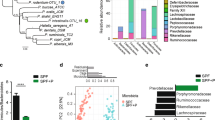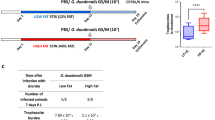Abstract
The composite human microbiome of Western populations has probably changed over the past century, brought on by new environmental triggers that often have a negative impact on human health1. Here we show that consumption of a diet high in saturated (milk-derived) fat, but not polyunsaturated (safflower oil) fat, changes the conditions for microbial assemblage and promotes the expansion of a low-abundance, sulphite-reducing pathobiont, Bilophila wadsworthia2. This was associated with a pro-inflammatory T helper type 1 (TH1) immune response and increased incidence of colitis in genetically susceptible Il10−/− , but not wild-type mice. These effects are mediated by milk-derived-fat-promoted taurine conjugation of hepatic bile acids, which increases the availability of organic sulphur used by sulphite-reducing microorganisms like B. wadsworthia. When mice were fed a low-fat diet supplemented with taurocholic acid, but not with glycocholic acid, for example, a bloom of B. wadsworthia and development of colitis were observed in Il10−/− mice. Together these data show that dietary fats, by promoting changes in host bile acid composition, can markedly alter conditions for gut microbial assemblage, resulting in dysbiosis that can perturb immune homeostasis. The data provide a plausible mechanistic basis by which Western-type diets high in certain saturated fats might increase the prevalence of complex immune-mediated diseases like inflammatory bowel disease in genetically susceptible hosts.
This is a preview of subscription content, access via your institution
Access options
Subscribe to this journal
Receive 51 print issues and online access
$199.00 per year
only $3.90 per issue
Buy this article
- Purchase on Springer Link
- Instant access to full article PDF
Prices may be subject to local taxes which are calculated during checkout




Similar content being viewed by others
Accession codes
Primary accessions
GenBank/EMBL/DDBJ
Data deposits
Data have been deposited in GenBank under accession numbers JQ890637–JQ894320.
References
Walter, J. & Ley, R. The human gut microbiome: ecology and recent evolutionary changes. Annu. Rev. Microbiol. 65, 411–429 (2011)
Baron, E. J. Bilophila wadsworthia: a unique Gram-negative anaerobic rod. Anaerobe 3, 83–86 (1997)
Molodecky N. A. et al. Increasing incidence and prevalence of the inflammatory bowel diseases with time, based on systematic review. Gastroenterology 142, 46–54 (2012)
Maslowski, K. M. & Mackay, C. R. Diet, gut microbiota and immune responses. Nature Immunol. 12, 5–9 (2011)
NHANES. Trends in intake of energy and macronutrients—Unites States 1971–2000 http://www.cdc.gov/mmwr/preview/mmwrhtml/mm5304a3.htm (2004)
Turnbaugh, P., Bäckhed, F., Fulton, L. & Gordon, J. I. Diet-induced obesity is linked to marked but reversible alterations in the mouse distal gut microbiome. Cell Host Microbe 3, 213–223 (2008)
Hildebrandt, M. A. et al. High-fat diet determines the composition of the murine gut microbiome independently of obesity. Gastroenterology 137, 1716–1724 (2009)
Baron, E. J. et al. Bilophila wadsworthia, a unique Gram-negative anaerobic rod recovered from appendicitis specimens and human faeces. J. Gen. Microbiol. 135, 3405–3411 (1989)
Attene-Ramos, M. S., Wagner, E. D., Plewa, M. J. & Gaskins, H. R. Evidence that hydrogen sulfide is a genotoxic agent. Mol. Cancer Res. 4, 9–14 (2006)
Loubinoux, J., Bronowicji, J.-P., Peireira, I. A. C., Mougenet, J. L. & Le Faou, A. E. Sulphate reducing bacteria in human faeces and their association with inflammatory diseases. FEMS Microbiol. Ecol. 40, 107–112 (2002)
Rowan, F. E., Docherty, N. G., Coffey, J. C. & O’Connell, P. R. Sulphate-reducing bacteria and hydrogen sulphide in the etiology of ulcerative colitis. Br. J. Surg. 96, 151–158 (2009)
Beech, I. B. & Zinkevich, V. Screening of sulfate-reducing bacteria in colonoscopy samples from healthy and colitic human gut mucosa. FEMS Microbiol. Ecol. 2, 147–155 (2000)
Gibson, G. R., Cummings, J. H. & Macfarlane, G. T. Growth and activities of sulphate-reducing bacteria in gut contents of healthy subjects and patients with ulcerative colitis. FEMS Microbiol. Ecol. 86, 103–112 (1991)
Scanlan, P. D., Shanahan, F. & Marchesi, J. Culture-independent analysis of desulfovibrios in the human distal colon of healthy, colorectal cancer and polypectomized individuals. FEMS Microbiol. Ecol. 69, 213–221 (2009)
Arzese, A., Mercuri, F., Trevisan, R., Menozzi, G. & Botta, G. Recovery of Bilophila wadsworthia from clinical specimens in Italy. Anaerobe 3, 219–224 (1997)
Baron, E. J. et al. Bilophila wadsworthia isolates from clinical specimens. J. Clin. Microbiol. 30, 1882–1887 (1992)
Laue, H., Denger, K. & Cook, A. M. Taurine reduction in anaerobic respiration of Bilophila wadsworthia RZATAU. Appl. Environ. Microbiol. 63, 2016–2021 (1997)
Lindstedt, S., Avigan, J., Goodman, D. S., Sjovall, J. & Steinberg, D. The effects of dietary fat on the turnover of cholic acid and on the composition of the biliary bile acids in man. J. Clin. Invest. 44, 1754–1765 (1965)
Rueda, A. et al. Conjugated bile acids and intestinal flora during the preruminant stage in goat: influence of a lamb milk replacer. Arch. Physiol. Biochem. 104, 246–251 (1996)
Graham, T. O., Van Thiel, D. H., Little, J. M. & Lester, R. Synthesis of taurocholate by rat fetal liver in organ culture: effects of cortisol in vitro . Am. J. Physiol. 237, E177–E184 (1979)
Ananieva, O., Nilsson, I., Vorobjova, T., Uibo, R. & Wadström, T. Immune responses to bile-tolerant Helicobacter species in patients with chronic liver diseases, a randomized population group, and healthy blood donors. Clin. Vaccine Immunol. 9, 1160–1164 (2002)
Dussurget, O., Cabanes, D., Dehoux, P. & Lecuit, M. Listeria monocytogenes bile salt hydrolase is a PrfA-regulated virulence factor involved in the intestinal and hepatic phases of listeriosis. Mol. Microbiol. 4, 1098–1106 (2002)
Wang, a. l. Regional mucosa-associated microbiota determine physiological expression of TLR2 and TLR4 in murine colon. PLoS ONE 5, e13607 (2010)
Wang, Y. et al. 16S rRNA gene-based analysis of fecal microbiota from preterm infants with and without necrotizing enterocolitis. ISME 3, 944–954 (2009)
Berg, D. J. et al. Enterocolitis and colon cancer in interleukin-10-deficient mice are associated with aberrant cytokine production and CD4+ TH1-like responses. J. Clin. Invest. 4, 1010–1020 (1996)
Rossi, S. S., Converse, J. L. & Hofmann, A. F. High pressure liquid chromatographic analysis of conjugated bile acids in human bile: simultaneous resolution of sulfated and unsulfated lithocholyl amidates and the common conjugates bile acids. J. Lipid Res. 28, 589–595 (1987)
Acknowledgements
This work was supported by the National Center for Research Resources and the NIDDK, NIGMS and NCCAM of the National Institutes of Health through grant number DK-42086 (E.B.C.), DK47722 (E.B.C.), UH3DK083993 (E.B.C.), F31AT006073 (S.D.). Also, the Gastrointestinal Research Foundation, Crohns and Colitis Foundation of America (Y.W.), the Peter and Carol Goldman Family Research Fund, and the Harry and Leona Helmsley Trust Foundation (SHARE). We are also indebted to S. Finegold for his suggestions on successful culture of B. wadsworthia and Alistipes, J. Tiedje and M. Vital for dsrA primer sequences, L. Hagey for mass spectrometry, E. Huang, B. Theriault and J. Stencel for assistance with experiments, and R. Bouziat for T-cell purification.
Author information
Authors and Affiliations
Contributions
S.D. and E.B.C. were involved in all aspects of this study, especially in the development of the hypothesis, experimental plan and data analysis. Y.W., M.W.M., V.L., H.F.-P. and A.N. helped perform the experiments. D.A.A. and B.J. provided critical feedback and expertise and assisted in the analysis of data.
Corresponding author
Ethics declarations
Competing interests
The authors declare no competing financial interests.
Supplementary information
Supplementary Information
This file contains Supplementary Figures 1-8 and Supplementary Tables 1-4. (PDF 4720 kb)
Rights and permissions
About this article
Cite this article
Devkota, S., Wang, Y., Musch, M. et al. Dietary-fat-induced taurocholic acid promotes pathobiont expansion and colitis in Il10−/− mice. Nature 487, 104–108 (2012). https://doi.org/10.1038/nature11225
Received:
Accepted:
Published:
Issue Date:
DOI: https://doi.org/10.1038/nature11225
This article is cited by
-
The gut-liver axis in hepatobiliary diseases
Inflammation and Regeneration (2024)
-
Dietary interventions in Crohn’s disease: A simple solution to refractory disease
Indian Journal of Gastroenterology (2024)
-
Gut microbiota analyses of inflammatory bowel diseases from a representative Saudi population
BMC Gastroenterology (2023)
-
Analysis of strain, sex, and diet-dependent modulation of gut microbiota reveals candidate keystone organisms driving microbial diversity in response to American and ketogenic diets
Microbiome (2023)
-
The roles of dietary lipids and lipidomics in gut-brain axis in type 2 diabetes mellitus
Journal of Translational Medicine (2023)
Comments
By submitting a comment you agree to abide by our Terms and Community Guidelines. If you find something abusive or that does not comply with our terms or guidelines please flag it as inappropriate.



